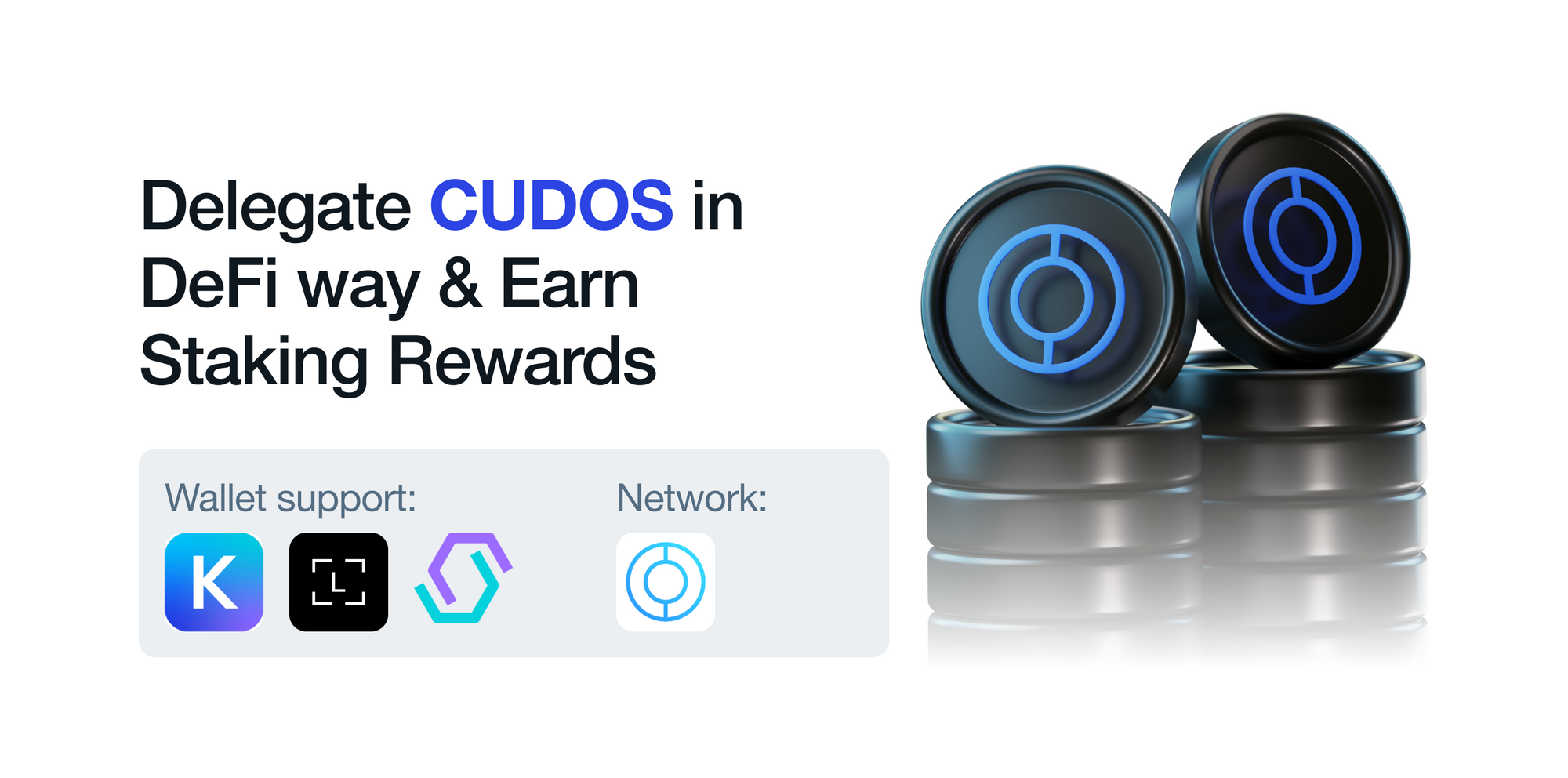Cudos (CUDOS) - Cold Staking & Delegations
Stake your Cudos (CUDOS) coins directly from your own wallets and earn in a non-custodial way. Your keys, your crypto rewards.

Delegate CUDOS in DeFi way & Earn Staking Rewards
Delegate (stake) your Cudos coins directly from your own wallets and earn in a non-custodial way. Your keys, your crypto rewards.

Asset
Cudos
Ticker
CUDOS
APR
~7.7%
Min. stake
any amount
Payout Frequency
~6.15 sec
Unbonding Period
21 days
Staking Providers
Wallets supported
Earn Network (auto-compounding available!)
1. Open CUDOS dedicated page on Earn Network.
2. Connect with your Keprl wallet. If you haven’t added $CUDOS to Keplr yet, do so now. Pop-ups will appear for both adding its network and making the connection between Earn Network dApp with Keplr.
3. Navigate to the 'Delegate' tab and input the number of coins you want to delegate. Remember to leave a small amount for transaction fees. A Keplr pop-up will appear for you to confirm the transaction.
4. Once you confirm, your tokens will be delegated. To maximize your returns make sure to enable auto-compounding to utilize restaking feature.
Full $CUDOS delegation & restaking guide is available on Earn Network's blog.

Keplr
1. Sign in to your Keplr wallet.
2. Go to Cudos dashboard and connect your wallet.
3. Go to the “Stake” tab (2 arrows on the left sidebar).
4. Find one of our recommended validators and click the “Delegate” button on the right.
5. Enter the amount of CUDOS you want to stake, select “Submit” and then “Approve” in the Keplr pop-up window. That’s it.
Enjoy your rewards on cold staking!


Ledger via Keplr
We assume that the user has already configured its Ledger Live App, installed the Cosmos App, and have some coins there.
1. Click on the Keplr extension icon and click on the “Accounts” icon.
2. Click on the “Add account” button and select “Import ledger”.
3. Set the name of the Ledger account, press “Next”.
4. Connect your Ledger device to your computer and open the Cosmos app on your device and then press “Next” and you’re all set!
5. Go to Cudos dashboard and click "Connect Keplr Wallet".
6. Go to the “Stake” tab (2 arrows on the left sidebar).
7. Find one of our recommended validators and click the “Delegate” button on the left side.
8. Enter the amount of CUDOS you want to stake, select “Submit” and then confirm the transaction on your Ledger device/Keplr. That’s it.
Enjoy your rewards on cold staking!

Comostation
1. Sign in to your Cosmostation Wallet.
2. Go to Cudos dashboard and connect your wallet.
3. Go to the “Stake” tab (2 arrows on the left sidebar).
4. Find one of our recommended validators and click the “Delegate” button on the right.
5. Enter the amount of CUDOS you want to stake, select “Submit” and then “Approve” in the Cosmostation pop-up window. That’s it.
Enjoy your rewards on cold staking!
Check other assets
Delegate coins to nodes or stake with MyCointainer decentralized pools always having funds in your wallet and under control.

Frequently Asked Questions
How does Cold Staking work?
Cold staking is an innovative approach to earning passive income from your cryptocurrencies. To begin cold staking, users must store their assets in a non-custodial wallet and delegate their coins to a MyCointainer node or similar validators.
Your participation in cold staking entitles you to receive rewards in the form of additional tokens, and further creates a bigger impact on network security, and decentralization of the protocol.
What is Annual Percentage Rate (APR) and how is it calculated?
The annual percentage rate (APR) for delegators to dPoS validators is calculated based on several factors, including:
- Block rewards: The rewards earned from validating blocks and creating new blocks are distributed among validators and their delegators. The amount of rewards each delegator receives is proportional to the amount of stake they have delegated to the validator.
- Commission rate: The commission rate is a percentage of the rewards earned by the validator that is taken as a fee. This fee is taken from the rewards earned by the validator and its delegators.
- Inflation rate: The inflation rate of the underlying cryptocurrency affects the overall rewards earned by the validator and its delegators.
- Network performance: The network performance, such as the rate of block production, can also impact the APR earned by delegators.
All these factors are combined to calculate the APR for delegators to dPoS validators, which should be treated as estimate of the expected returns for staking over a certain period of time.
Will the APR always be a fixed percent?
There are factors that can move the APR up or down. Rates can be influenced by the network’s conditions, inflation, number of stakers and staked assets, and the validator’s performance.
When will I receive my Cold Staking rewards?
The frequency of rewards distribution for cold staking assets in dPoS assets typically varies depending on the specific network details. In some cases, rewards are distributed on a weekly or monthly basis, while in others, rewards are distributed daily or even often. It ultimately depends on the design of the particular network, and for some of them, you will need to claim produced rewards before making them free to use.
Are there fees for Cold Staking?
Yes, there can be fees associated with Cold Staking. They may vary depending on the specific dPoS network and the Cold Staking Provider you use. Besides rewards fees which node operators typically set up, there are network fees associated with executing delegation.
Can I access my assets while Cold Staking?
Since the assets are stored in your personal cold wallet, you always have access to your investments. You can unstake your assets anytime, but consider that various assets have different unbonding periods that are governed by the blockchain network.
